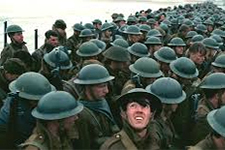Dunkirk
|  Walking out of Christopher Nolan’s Dunkirk, I felt that I had just seen something quite masterful: a taut, efficient, viscerally impactful depiction of the momentous week in early June 1940 when some 300,000 Allied troops found themselves pinned on the beaches of northern France by German forces and were eventually evacuated across the English Channel—what Winston Churchill called “a miracle of deliverance.” But now, several days later, I am not so sure. The immediate impact of Dunkirk is undeniable, as Nolan marshals virtually all of his impressive resources and skills into creating an intense sense of being there—there being the beaches of Dunkirk, the waters between it and England, and the skies above it. As an artist who is deeply committed to the ideals of physical, epic moviemaking, Nolan again invested his clout (as did with his previous film, 2014’s Interstellar) to ensure that Dunkirk would be shot not just on celluloid, but 65mm, and projected as often as possible in the largest IMAX formats. Everything about the film is designed to put you right there in the moment, and in that regard it is a grand accomplishment. And yet … and yet … days later, I can’t escape the nagging feeling that Dunkirk, for all its immediate impact, is missing something substantial. The technical details feel right, the scope of the film is impressive, the cinematography by Hoyte Van Hoytema (who also shot Interstellar) is beautiful and effective, the masterful merging of a detailed sonic soundscape with Hans Zimmer’s throbbing musical score gives the film an undeniably physical experience. And yet … and yet … there is something decidedly missing, something crucial to such a film that isn’t there—not by accidental omission, but by obvious design. And that is the human element. While Dunkirk is filled with human beings, sometimes thousands at a time when the Allies troops are lined up on the desolate beaches awaiting extraction, there is nonetheless a distinct lack of human presence in the film. There are characters with whom we identify to some degree and for whom we feel, but they are marginalized to such a degree that they leave no lasting impact. Many of them either don’t have names or their names are mentioned so briefly and with such little importance that it’s impossible to remember them. Many of the young soldiers are physically similar in appearance, and at times we have to work to remember who is who at any given moment. This creates an alienating effect that you don’t fully experience during the film because the film itself is such an experience, but dominates the lingering aftermath. As he has with virtually all of his films, beginning with his noiresque no-budget feature debut Following (1998), Nolan takes an experimental approach to the film’s temporal dimension. The film is comprised of three interlocking narratives that allow us to experience what was happening at Dunkirk from three distinct vantage points, but rather than arranging them in a traditional linear manner, Nolan fractures and then interweaves them by having each narrative occupy a distinctly different timeframe. “The Mole,” which focuses on the soldiers on the beach awaiting the ships that will eventually rescue them, takes place over a week; “The Sea,” which focuses on the hundreds of civilian vessels that were called into action by the British Navy to sail across the channel and help bring the soldiers home, takes place over a day; and “The Air,” which focuses on the British fighter planes that helped provide air cover during the rescue operation, takes place over one hour (all these time frames are made clear with intertitles, so there is no confusion). Each of these stories is centered around a small group of characters who help clarify the stakes. In “The Mole,” the central character is an unnamed British soldier (Fionn Whitehead) who is desperately trying to find an alternate escape route off the beach, while Kenneth Branagh plays a British officer overseeing the evacuation; in “The Sea,” the main character is a father (Mark Rylance) who sails across the channel with his teenage son (Tom Glynn-Carney) and his son’s friend (Barry Keoghan), picking up a shell-shocked British soldier along the way (Cillian Murphy); and in “The Air,” we see inside the cockpit of two Spitfire pilots (Tom Hardy and Jack Lowden) as they take out Nazi planes attempting to bomb the ships. These characters play important roles and sometimes generate conflicting emotions (such as when Murphy’s terrified soldier attempts to force Rylance’s steadfast character to turn the boat around), but they leave little to no lasting impact. This is perhaps most true of Hardy’s pilot, who is little more than a cypher for self-sacrifice and heroism. And that’s where Dunkirk stumbles, albeit in a clearly intentional way. Nolan is so intent on ensuring that we experience what the characters are experiencing that he jettisons any need to make them actual characters beyond the barest of necessity. That is a crucial risk on his part, and to some extent I can’t help but be impressed by his willingness to forego something so elemental to the big-budget movie experience as character, which further proves his experimental bona fides and willingness to risk his stature as one of Hollywood’s leading filmmakers to follow his artistic instincts (unlike, say, Michael Bay, whose failure to create memorable or realistic characters is not an intentional artistic choice, but a fatal artistic flaw). There is greatness scattered all throughout Dunkirk—moments of intense excitement and suspense, creative deployment of familiar scenarios, a studious merging of image of sound to draw us into the world it’s depicting—yet it is not a great film because it is too deeply and singularly invested in its aesthetic drive, which at times pushes the film into a dangerous sense of repetition (this is particularly true of the aerial sequences, which eventually start to blur together). Had Nolan gone truly experimental and jettisoned all pretenses toward character and story, the film would have been something different and perhaps even better. But, because he maintains those pretenses but refuses to fully engage them, Dunkirk ends up feeling unbalanced and unmoored, drawing us deep into something from which we emerge with an initial sense of thrill, but are ultimately left with a lingering sense of what might have been. Copyright © 2017 James Kendrick Thoughts? E-mail James Kendrick All images copyright © Warner Bros. |
Overall Rating: 

 (2.5)
(2.5)


